Hereditary Angioedema Market Size
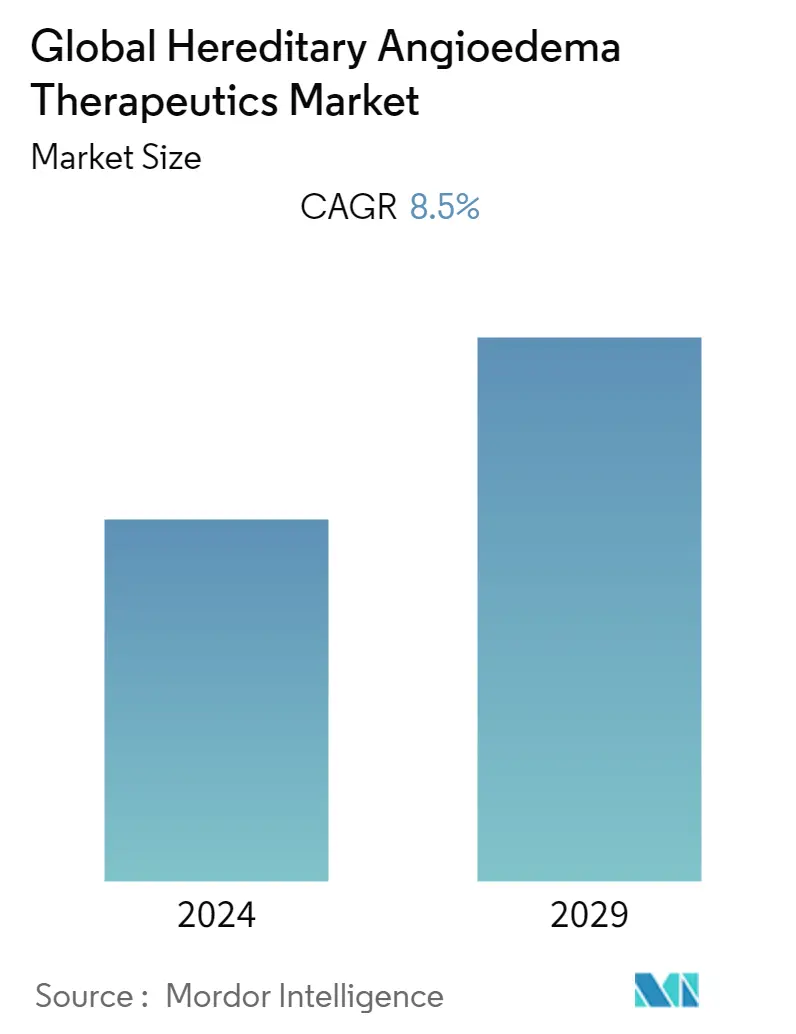
| Study Period | 2019 - 2029 |
| Base Year For Estimation | 2023 |
| Forecast Data Period | 2024 - 2029 |
| CAGR | 8.50 % |
| Fastest Growing Market | Asia Pacific |
| Largest Market | North America |
Major Players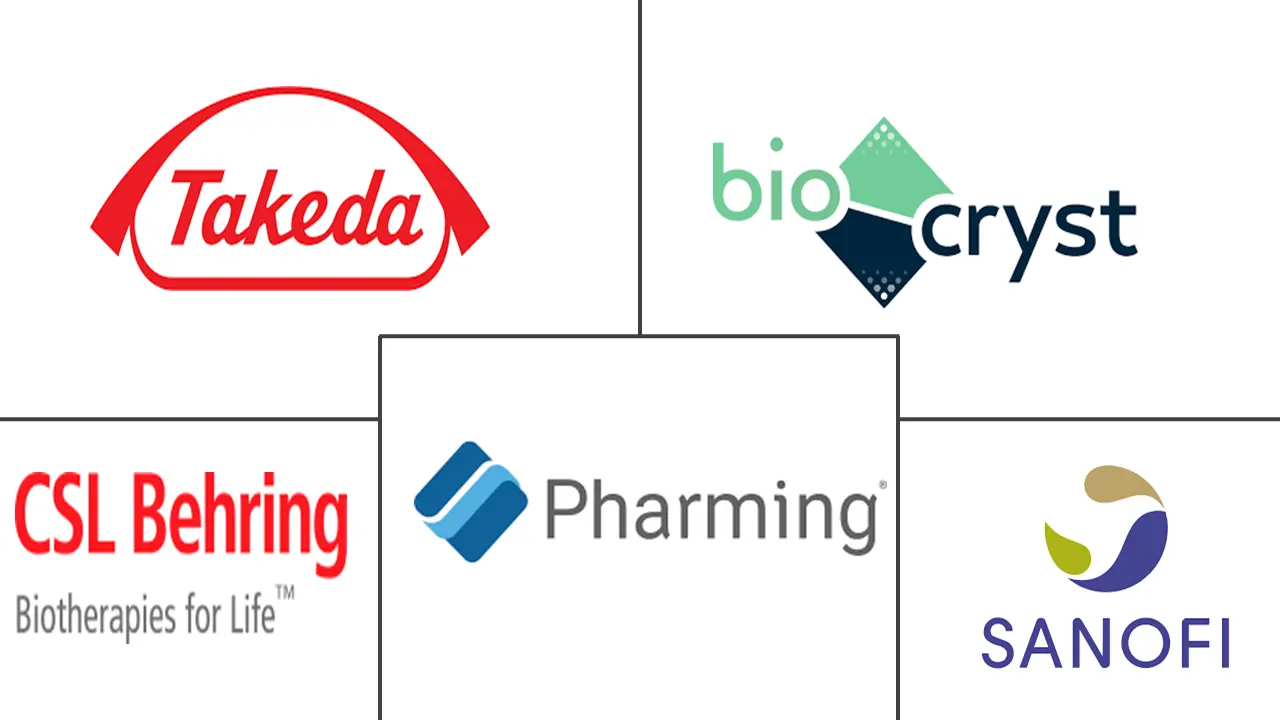
*Disclaimer: Major Players sorted in no particular order |
Hereditary Angioedema Market Analysis
The hereditary angioedema therapeutics market is expected to register a CAGR of 8.5% during the forecast period.
During the pandemic, there has been a continuous urge to develop a treatment and vaccine for COVID-19. Pharmaceutical companies have dedicated their R&D resources to support the COVID-19 vaccine development. R&D activities for rare diseases, including hereditary angioedema, have been outlined for the time being in R&D laboratories. However, some companies are focusing their R&D resources on understanding the effect of COVID-19 in patients with rare diseases and carrying out esoteric testing to determine novel therapies for COVID-19 patients.
The major factor attributing to the market's growth is the increasing awareness of treating rare diseases, such as hereditary angioedema (HAE). As per the National Organization for Rare Disorders (NORD), the condition is believed to affect about 1 in 50,000 people, and 1 in 150,000 individuals is affected by this disorder worldwide. Angioedema attacks usually occur in sudden, regularly painful swelling in numerous parts of the body, involving the abdomen, extremities, throat, and face. Many organizations are spreading awareness about the diseases and their treatment, like the US Hereditary Angioedema Association, a non-profit organization dedicated to offering HAE patients access to the latest treatment options and dependable, personal support to address symptoms and the challenges associated with the condition. As per an article published on the National Library of Medicine in October 2020, a study was conducted in 2020 to evaluate the current HAE management and the new treatment options on physician practice patterns over time. The study suggested that physicians reported improvements in HAE management in recent years as per the survey conducted in the United States. Owing to the current therapeutic advances, the reported cases of HAE have improved and reduced concern of adverse treatment effects, and high levels of patient satisfaction have been observed. According to an article titled 'Spectrum of diagnosis of hereditary angioedema: Seven case reports' published in July 2020, there are approximately 30,000-50,000 affected patients in India. Most cases are managed by dermatologists, gastroenterologists, and clinical allergists.
The increased funding for rare genetic diseases and orphan drugs by governments and private companies is also increasing the pharmaceutical companies' interest in developing drugs for hereditary angioedema, thus fueling the market's growth. For instance, in November 2020, Takeda Pharmaceutical entered an agreement for public funding of Takhzyro (Lanadelumab) in Canada to treat hereditary angioedema (HAE) patients. The National Institutes of Health (NIH) also supports research to improve people's health with rare diseases. Most of the 27 Institutes and Centers receive NIH funds for medical research of rare diseases. However, misdiagnosis of the condition as common allergies, appendicitis, and irritable bowel syndrome has interrupted the treatment, thus negatively impacting the growth of the hereditary angioedema treatment market.
Hereditary Angioedema Market Trends
This section covers the major market trends shaping the Hereditary Angioedema Therapeutics Market according to our research experts:
The Kallikrein Inhibitors Segment is the Fastest Growing in the Hereditary Angioedema Therapeutics Market
Kallikrein inhibitors are expected to be the fastest-growing segment over the forecast period. Currently, various kallikrein inhibitors are being evaluated due to their potential to prevent edematous HAE attacks. This comparatively emerging class of drug therapy has several potential molecules in the pipelines, the commercialization of which is expected to fuel the market growth. For instance, BioCryst is developing a novel treatment to treat and prevent angioedema attacks in patients with hereditary angioedema (HAE) and evaluating the molecule APeX-1, an oral, once-daily, selective inhibitor of plasma kallikrein. Also, pharmaceutical companies are rapidly seeking approval in this class of drugs due to lesser competition in this market space. For instance, in August 2020, the US Food and Drug Administration approved Takhzyro (Lanadelumab). It is the first monoclonal antibody that targets kallikrein and is indicated for treating patients aged 12 years and older with types I and II HAE.
In December 2021, BioCryst Pharmaceuticals was granted USD 350 million to help fund the global launch of Orladeyo (Berotralstat), an oral treatment for preventing hereditary angioedema (HAE) swelling attacks. It works by inhibiting kallikrein activity.
Due to such developments, the kallikrein inhibitors segment is expected to augment the market's growth. The increasing R&D and funding for orphan drug development and rare genetic disorders are expected to further fuel the market's growth. For instance, the Indian Ministry of Health and Family Welfare developed a National Policy to treat rare diseases in India to progressively expand India's capabilities to treat rare diseases. Hence, the increased funding for R&D for new drugs is propelling the segment's growth.
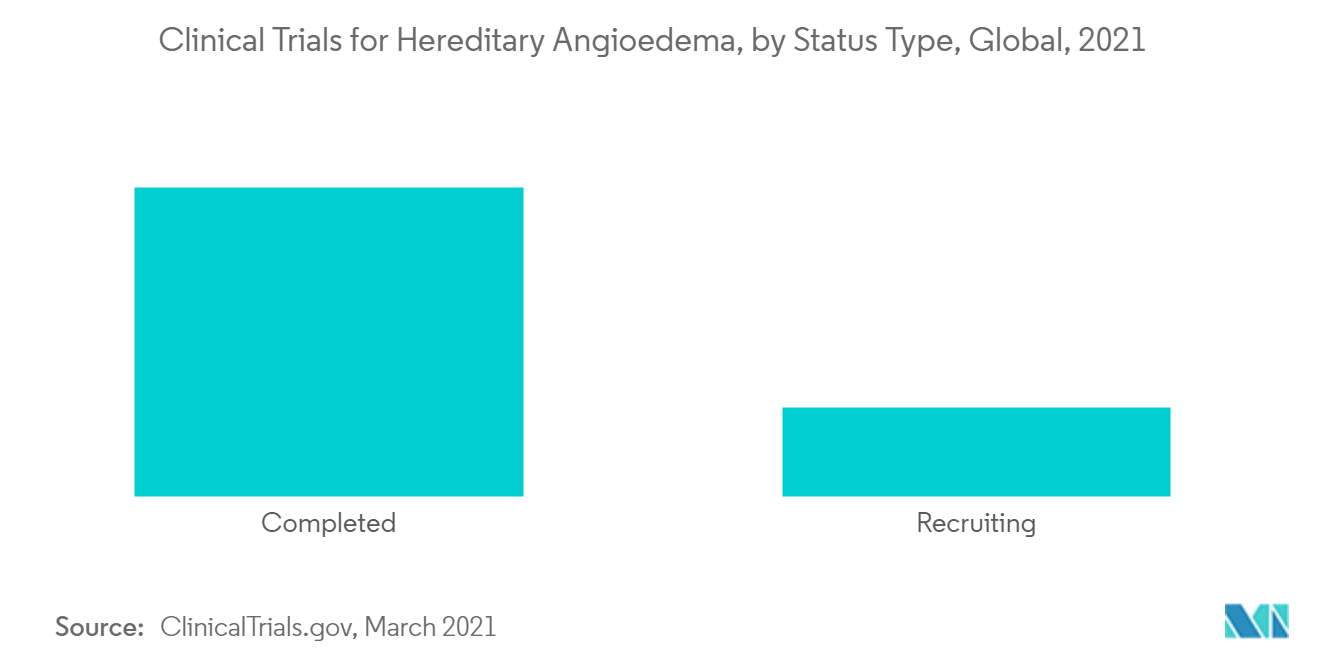
North America Dominates the Market and is Expected to Continue the Domination During the Forecast Period
North America is expected to dominate the overall hereditary angioedema market during the forecast period due to the presence of key players, increasing awareness programs and research organizations regarding the treatment of the condition, and established healthcare infrastructure. The increasing government initiatives, rising research partnerships, and a robust pipeline are the major growth drivers of the market.
For instance, Ionis Pharmaceuticals, a biotechnology company based in California, has IONIS-PKK-LRx, a ligand-conjugated (LICA) investigational antisense medicine in its pipeline. The company is evaluating the drug molecule to reduce the production of prekallikrein, or PKK, to treat patients with hereditary angioedema. In September 2021, Cycle Pharmaceuticals launched SAJAZIR (Icatibant) Injection, a new treatment option for patients affected by hereditary angioedema (HAE) approved by the US FDA. The region has many government- and non-government-funded research institutions. For instance, the National Center for Advancing Translational Sciences (NCATS) is entirely focused on esoteric testing for the cure and treatments for rare diseases. NCATS aims to get collaborative projects to study common themes and causes of related diseases to speed the development of treatments. Hence, due to such factors, the market is anticipated to have lucrative growth in the future.
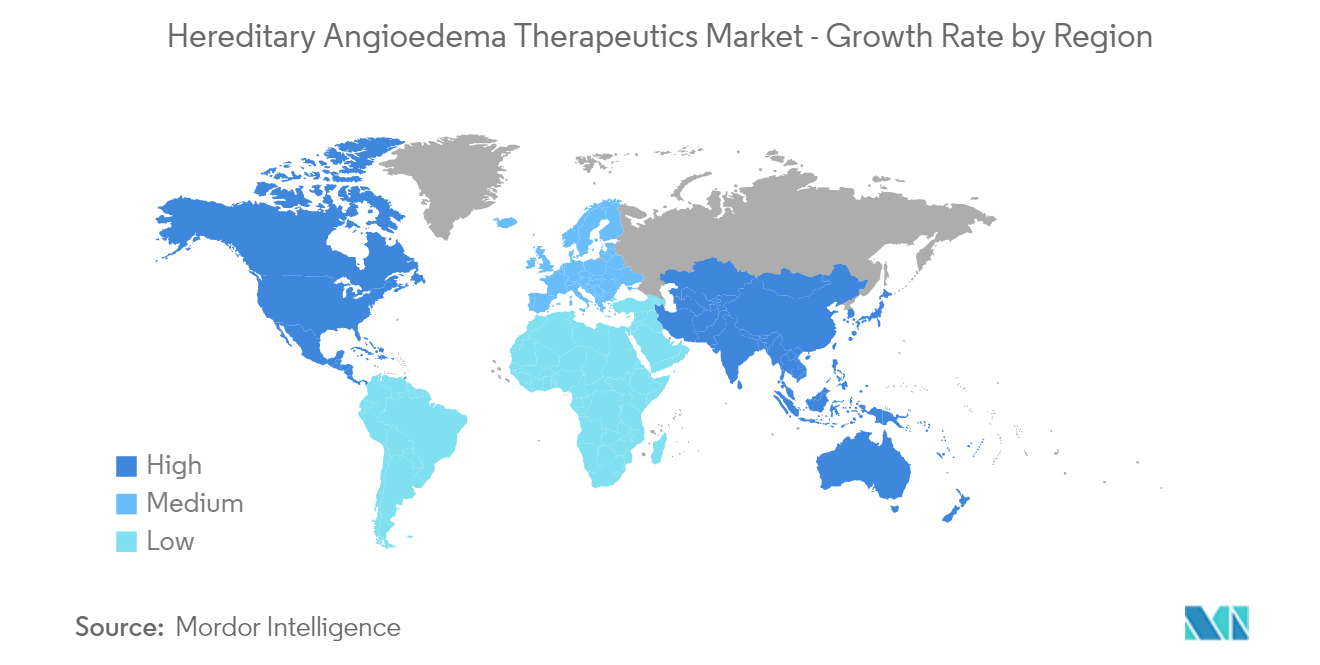
Hereditary Angioedema Industry Overview
The hereditary angioedema therapeutics market is highly consolidated in terms of competition and consists of limited major players. Some of the companies currently dominating the market are CSL Behring, Takeda Pharmaceutical Company Limited, Pharming Healthcare Inc., BioCryst Pharmaceuticals Inc., Attune Pharmaceuticals Inc., Ionis Pharmaceuticals, KalVista Pharmaceuticals Inc., and Adverum Biotechnologies Inc.
Hereditary Angioedema Market Leaders
-
CSL Behring
-
Takeda Pharmaceutical Company Limited
-
Pharming Healthcare Inc.
-
Sanofi
-
BioCryst Pharmaceuticals Inc.
*Disclaimer: Major Players sorted in no particular order
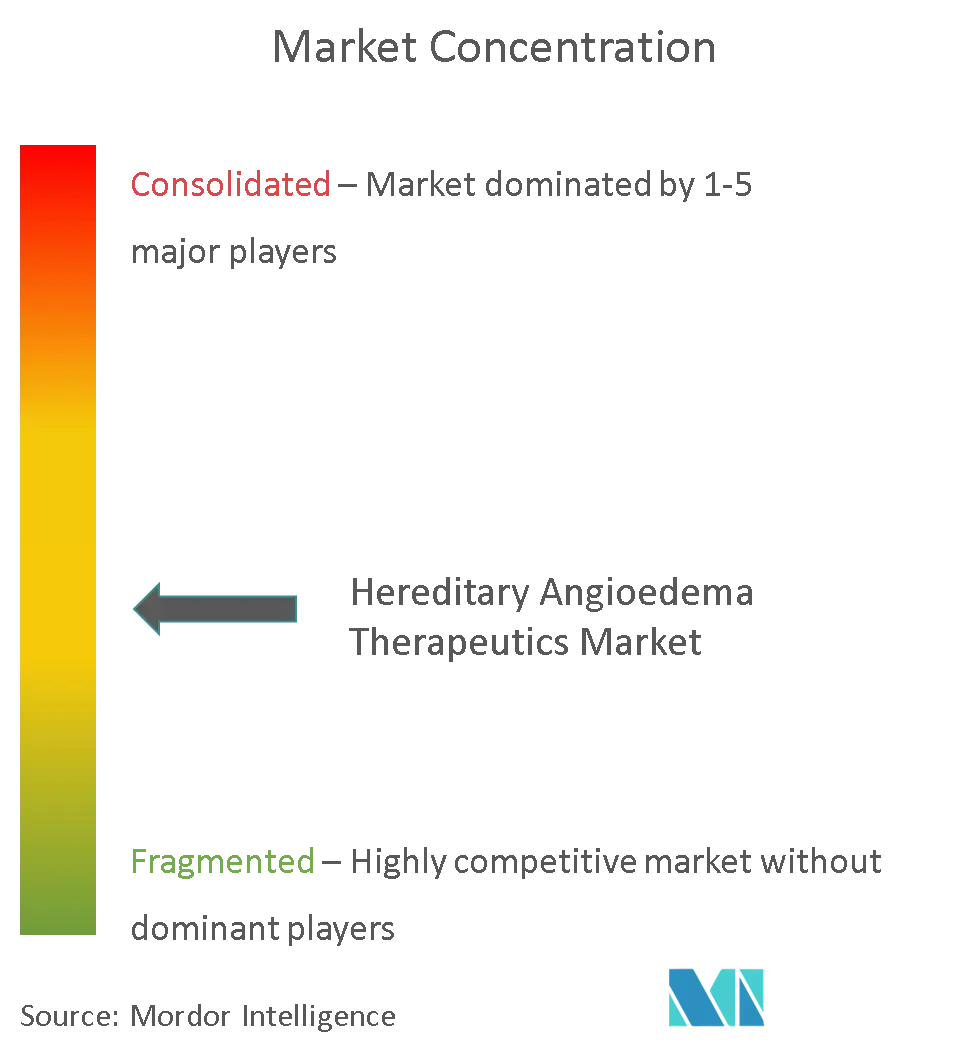
Hereditary Angioedema Market News
- In February 2021, BioCryst Pharmaceuticals Inc. announced that the Committee for Medicinal Products for Human Use (CHMP) of the European Medicines Agency (EMA) adopted a positive opinion recommending the approval of ORLADEYO (Berotralstat) for routine prevention of recurrent attacks of hereditary angioedema (HAE) in adult and adolescent patients aged 12 years and older.
- In February 2021, KalVista reported positive results in its Phase 2 clinical trial for KVD900 as an oral on-demand treatment for HAE attacks.
Hereditary Angioedema Market Report - Table of Contents
1. INTRODUCTION
- 1.1 Study Assumptions and Market Definition
- 1.2 Scope of the Study
2. RESEARCH METHODOLOGY
3. EXECUTIVE SUMMARY
4. MARKET DYNAMICS
- 4.1 Market Overview
-
4.2 Market Drivers
- 4.2.1 Rising Awareness Levels for Hereditary Angioedema
- 4.2.2 Increasing R&D and Funding for Orphan Drug Development
-
4.3 Market Restraints
- 4.3.1 Misdiagnosis of Hereditary Angioedema
-
4.4 Porter's Five Forces Analysis
- 4.4.1 Threat of New Entrants
- 4.4.2 Bargaining Power of Buyers/Consumers
- 4.4.3 Bargaining Power of Suppliers
- 4.4.4 Threat of Substitute Products
- 4.4.5 Intensity of Competitive Rivalry
5. MARKET SEGMENTATION (Market Size by Value - USD million)
-
5.1 By Drug Class
- 5.1.1 C1 Esterase Inhibitor
- 5.1.2 Selective Bradykinin B2 Receptor Antagonist
- 5.1.3 Kallikrein Inhibitor
- 5.1.4 Other Drug Classes
-
5.2 By Route of Administration
- 5.2.1 Intravenous
- 5.2.2 Subcutaneous Injection
- 5.2.3 Oral
-
5.3 By Geography
- 5.3.1 North America
- 5.3.1.1 United States
- 5.3.1.2 Canada
- 5.3.1.3 Mexico
- 5.3.2 Europe
- 5.3.2.1 Germany
- 5.3.2.2 United Kingdom
- 5.3.2.3 France
- 5.3.2.4 Italy
- 5.3.2.5 Spain
- 5.3.2.6 Rest of Europe
- 5.3.3 Asia-Pacific
- 5.3.3.1 China
- 5.3.3.2 Japan
- 5.3.3.3 India
- 5.3.3.4 Australia
- 5.3.3.5 South Korea
- 5.3.3.6 Rest of Asia-Pacific
- 5.3.4 Middle-East and Africa
- 5.3.4.1 GCC
- 5.3.4.2 South Africa
- 5.3.4.3 Rest of Middle-East and Africa
- 5.3.5 South America
- 5.3.5.1 Brazil
- 5.3.5.2 Argentina
- 5.3.5.3 Rest of South America
6. COMPETITIVE LANDSCAPE
-
6.1 Company Profiles
- 6.1.1 CSL Behring
- 6.1.2 Takeda Pharmaceutical Company Limited
- 6.1.3 Sanofi
- 6.1.4 Pharming Healthcare Inc.
- 6.1.5 BioCryst Pharmaceuticals Inc.
- 6.1.6 Attune Pharmaceuticals Inc.
- 6.1.7 Ionis Pharmaceuticals
- 6.1.8 KalVista Pharmaceuticals Inc.
- 6.1.9 Adverum Biotechnologies Inc.
- 6.1.10 Cipla Inc.
- 6.1.11 Arrowhead Pharmaceuticals Inc.
- *List Not Exhaustive
7. MARKET OPPORTUNITIES AND FUTURE TRENDS
** Subject To AvailablityHereditary Angioedema Industry Segmentation
Hereditary angioedema is a disease characterized by recurrent episodes of severe swelling of the skin and mucous membranes. The swelling most commonly affects the arms, intestinal tract, legs, face, and airway and is usually not itchy. The market is segmented by drug class (C1 esterase inhibitor, selective bradykinin B2 receptor antagonist, kallikrein inhibitor, and other drug classes), route of administration (intravenous, subcutaneous injection, and oral), and geography (North America, Europe, Asia-Pacific, Middle-East and Africa, and South America). The market report also covers the estimated market sizes and trends for 17 countries across major regions globally. The report offers the value in USD million for the above segments.
| By Drug Class | C1 Esterase Inhibitor | |
| Selective Bradykinin B2 Receptor Antagonist | ||
| Kallikrein Inhibitor | ||
| Other Drug Classes | ||
| By Route of Administration | Intravenous | |
| Subcutaneous Injection | ||
| Oral | ||
| By Geography | North America | United States |
| Canada | ||
| Mexico | ||
| By Geography | Europe | Germany |
| United Kingdom | ||
| France | ||
| Italy | ||
| Spain | ||
| Rest of Europe | ||
| By Geography | Asia-Pacific | China |
| Japan | ||
| India | ||
| Australia | ||
| South Korea | ||
| Rest of Asia-Pacific | ||
| By Geography | Middle-East and Africa | GCC |
| South Africa | ||
| Rest of Middle-East and Africa | ||
| By Geography | South America | Brazil |
| Argentina | ||
| Rest of South America |
Hereditary Angioedema Market Research FAQs
What is the current Global Hereditary Angioedema Therapeutics Market size?
The Global Hereditary Angioedema Therapeutics Market is projected to register a CAGR of 8.5% during the forecast period (2024-2029)
Who are the key players in Global Hereditary Angioedema Therapeutics Market?
CSL Behring, Takeda Pharmaceutical Company Limited, Pharming Healthcare Inc., Sanofi and BioCryst Pharmaceuticals Inc. are the major companies operating in the Global Hereditary Angioedema Therapeutics Market.
Which is the fastest growing region in Global Hereditary Angioedema Therapeutics Market?
Asia Pacific is estimated to grow at the highest CAGR over the forecast period (2024-2029).
Which region has the biggest share in Global Hereditary Angioedema Therapeutics Market?
In 2024, the North America accounts for the largest market share in Global Hereditary Angioedema Therapeutics Market.
What years does this Global Hereditary Angioedema Therapeutics Market cover?
The report covers the Global Hereditary Angioedema Therapeutics Market historical market size for years: 2019, 2020, 2021, 2022 and 2023. The report also forecasts the Global Hereditary Angioedema Therapeutics Market size for years: 2024, 2025, 2026, 2027, 2028 and 2029.
Hereditary Angioedema Treatment Industry Report
Statistics for the 2024 Hereditary Angioedema Treatment market share, size and revenue growth rate, created by Mordor Intelligence™ Industry Reports. Hereditary Angioedema Treatment analysis includes a market forecast outlook 2029 and historical overview. Get a sample of this industry analysis as a free report PDF download.



